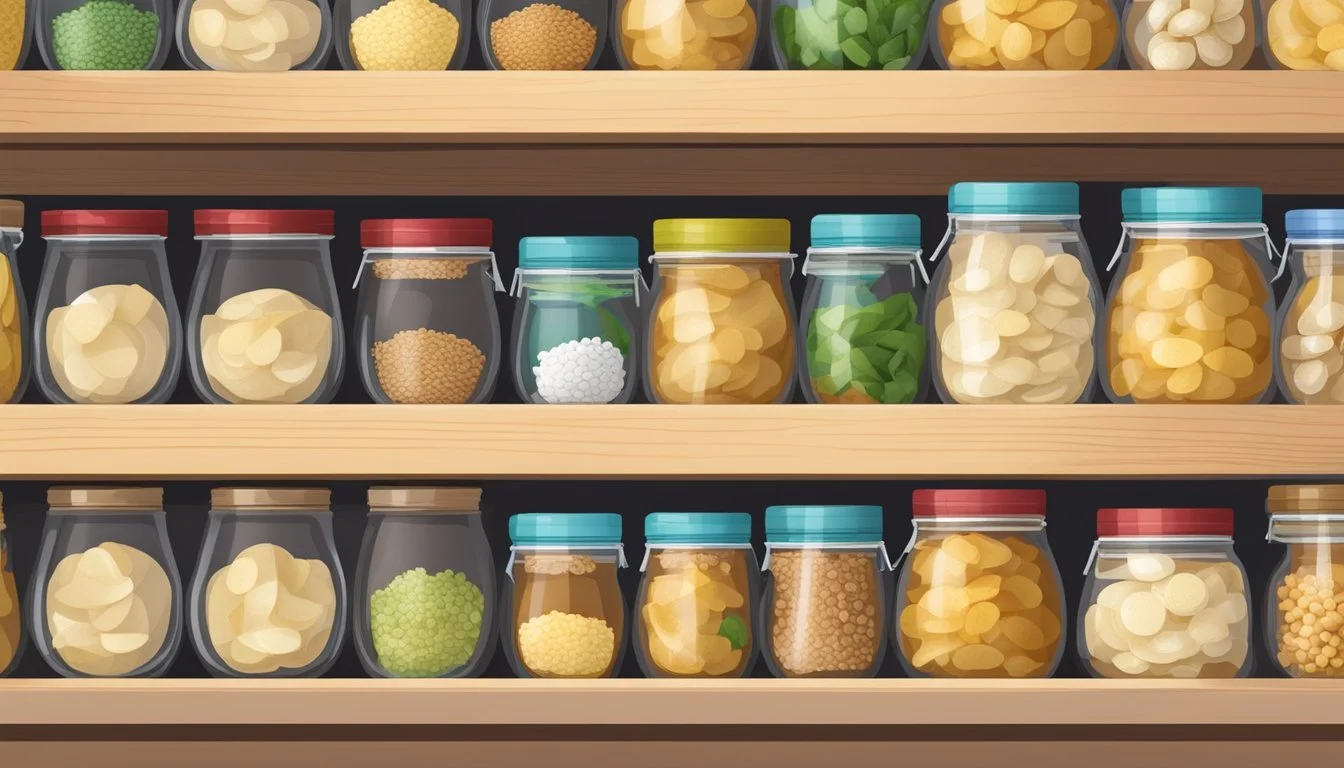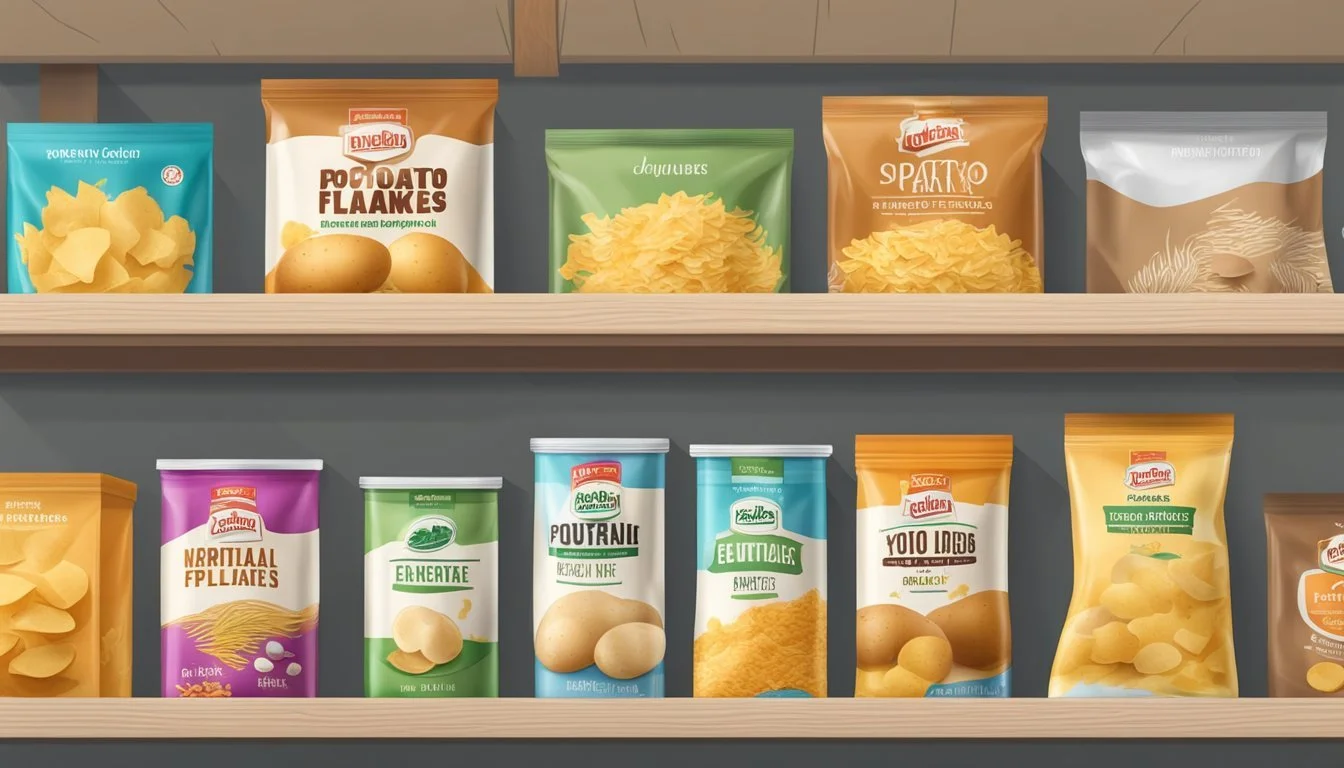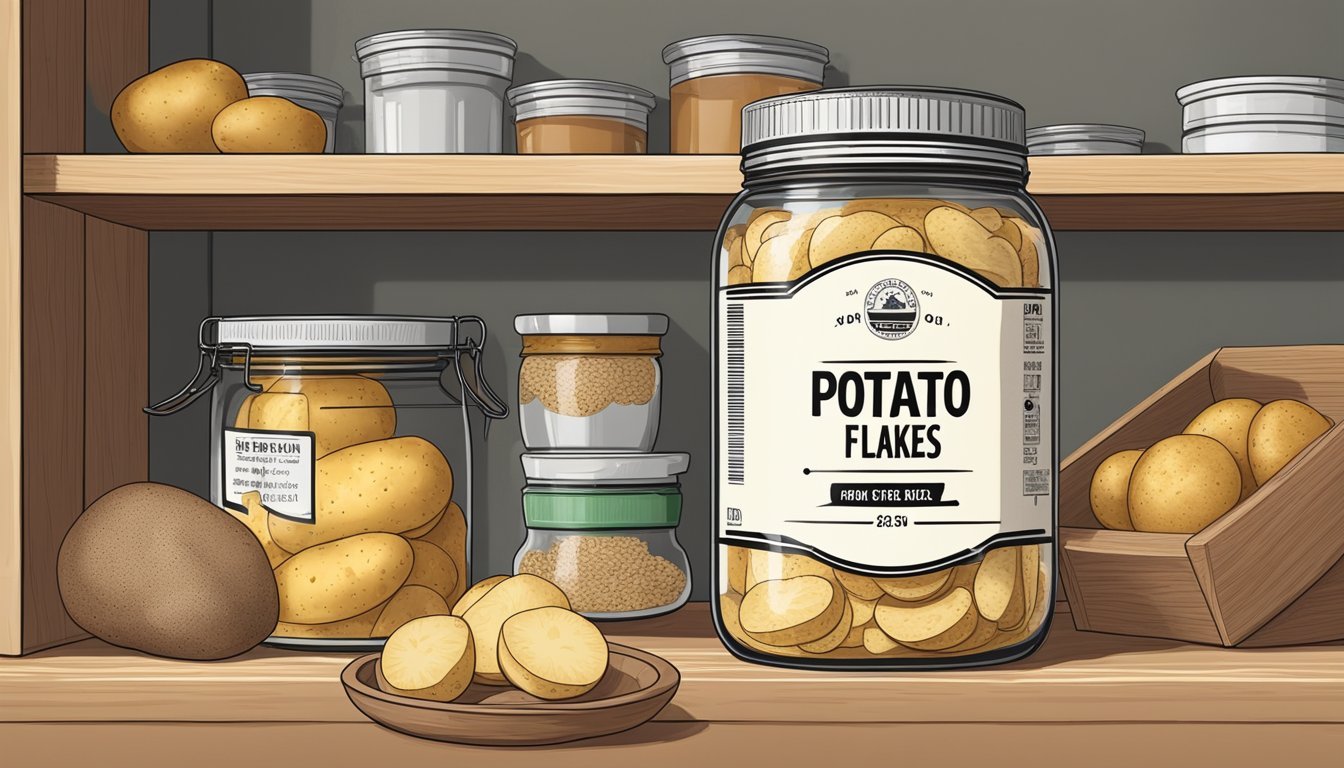How Long Do Potato Flakes Last?
Shelf Life and Storage Tips
Potato flakes are a convenient and non-perishable form of potatoes (What wine goes well with potatoes?) that have been cooked, mashed, dried, and flaked. This pantry staple has a specified shelf life typically ranging from 12 to 18 months, which can be found printed as a best-by date on the packaging. However, this date is often conservative, as the actual lifespan can extend beyond it when the flakes are stored properly.
The longevity of potato flakes is influenced by several factors, including storage conditions and whether the package has been opened. Unopened packets of potato flakes can retain their quality for months past their best-by date if kept in a dry, cool place away from direct light and heat sources. Once opened, maintaining this quality requires transferring the flakes to an airtight container to guard against moisture and other contaminants, which can hasten spoilage.
It's important to note that while potato flakes may remain safe to eat after the best-by date, there can be a gradual decline in taste and texture. Assessing the quality involves checking for any off odors, discoloration, or signs of insect contamination. Consuming potato flakes past their prime is not typically a safety concern, but it may affect the enjoyment and quality of the final prepared dish.
Understanding Potato Flakes
Potato flakes are a versatile and convenient food product, characterized by their composition, nutritional value, and the various types available in the market.
Composition and Nutritional Value
Potato flakes are dehydrated mashed potatoes formed into flakes. The dehydration process removes most of the water content, leaving behind a product rich in starch. Typically, these flakes contain additives such as monoglycerides to improve texture, citric acid to stabilize color, and sometimes sodium acid pyrophosphate to maintain freshness.
Nutritionally, potato flakes are an excellent source of nutrients. They provide complex carbohydrates, are low in fat, and contain moderate amounts of dietary fiber. They are also endowed with essential vitamins and minerals, making them a nutritious addition to meals. However, it's important to be aware that the nutritional value can be influenced by the added ingredients, such as salt or preservatives.
Nutrient Value per 100g Carbohydrates 83g Dietary Fiber 6.9g Protein 6.6g Fat 0.3g Vitamin C Variable* Potassium 1,150mg
*Vitamin C content can vary depending on the production process and additives.
Types and Varieties
Potato flakes are available in different types and varieties tailored for various culinary needs. They can range from plain, which contains just potatoes and perhaps citric acid to preserve color, to more seasoned options that might include herbs and additional flavorings. There are also varieties made to accommodate dietary restrictions, such as low-sodium or no-additives formulations.
From a culinary perspective, the types of potato flakes can be chosen based on the desired texture or flavor required for a recipe. For instance, some cooks might opt for a variety that produces a creamier mashed potato, while others may prefer flakes that are more suitable for bread-making or as a thickening agent in soups and stews.
Storage Fundamentals
Proper storage significantly extends the shelf life of potato flakes, maintaining their freshness and nutritional value. By controlling environmental factors and using appropriate containers, one can ensure potato flakes remain viable for long-term use.
Optimal Storage Conditions
Temperature and Humidity: Potato flakes need to be stored in a dry, cool environment. A consistent temperature between 50-70°F (10-21°C) and low humidity levels are ideal to prevent moisture absorption and microbial growth.
Exposure to Air: Limiting air exposure is crucial as oxygen can lead to oxidation, which diminishes quality over time. Using storage methods that reduce air contact with the potato flakes will retain their freshness for a longer period.
Packaging and Containers
Airtight Containers: The use of airtight containers is one of the most effective ways to store potato flakes. Containers such as Mason jars with tight seals or vacuum-sealed bags help protect against moisture and pests.
High-Barriers to Oxygen and Moisture:
Mylar Bags: Coupled with oxygen absorbers, Mylar bags offer high resistance to both oxygen and moisture, thus are excellent for prolonging shelf life.
Vacuum Sealing: Removes air from the package, further safeguarding against oxidation and spoilage.
Carefully selected storage containers and vigilant control of storage conditions are the foundations for maintaining the integrity of potato flakes for extended periods.
Shelf Life and Quality Preservation
In maintaining the quality and extending the shelf life of potato flakes, attention to storage conditions and signs of spoilage is crucial.
Factors Affecting Shelf Life
Potato flakes have a typical shelf life ranging from 12 to 18 months when stored under proper conditions, but they can last much longer if properly managed. The main factors influencing their longevity include:
Heat: Excessive heat can accelerate degradation, impacting the flavor and texture of the potato flakes.
Moisture: To prevent microbial growth and maintain freshness, potato flakes must be kept in a dry environment.
Airtight Sealing: Sealing potato flakes in an airtight container helps to preserve their quality and consistency.
Food Safety: Preventing exposure to contaminants ensures the potato flakes remain safe to consume.
The absence or control of these factors can extend the usability of potato flakes far beyond their best-by date, in some cases up to 25 years.
Identifying Spoilage
Potato flakes are generally shelf-stable, but they can spoil. Indicators of spoilage include:
Changes in Texture or Flavor: Altered texture or an off flavor can signal that potato flakes are no longer good to eat.
Visible Mold or Bacteria: Any visual signs of microbial growth such as mold indicate spoilage and the product should not be consumed.
Off Smell: An unpleasant smell is a clear sign that potato flakes have gone bad.
It is important to inspect potato flakes before use, especially if they are past the indicated best-by date, to ensure food safety and prevent consumption of spoiled goods.
Using Potato Flakes
Potato flakes offer a convenient and quick method to enjoy the taste of homemade mashed potatoes without the extensive preparation time. They can be an invaluable ingredient in the kitchen due to their ease of preparation and versatility in recipes.
Preparation Techniques
To reconstitute potato flakes into a mashed potato consistency, one generally needs to boil water or milk before adding in the flakes. The typical ratio is as follows:
1 cup of potato flakes
1 cup of boiling liquid (water, milk, or a blend of both)
Stirring is a critical part of the process; it blends the flakes with the liquid, creating a smooth and creamy texture. For those aiming for a richer taste, adding butter or cream and adjusting the amount of liquid can provide desired results. Flavors can be enhanced by incorporating seasonings or cheese.
Versatile Uses in Recipes
Potato flakes are not limited to just mashed potatoes; their ease of use extends to numerous recipes. Chefs may incorporate them in:
Thickening soups and stews: A tablespoon can quickly thicken a broth.
Breading: Provides a crispy coating for fried foods (What wine goes well with fried foods?).
Baking: Used in bread recipes for a tender crumb.
When cooking with potato flakes in an oven, they can be used as a topping for casseroles, delivering a pleasant textural contrast. For creative cooks, blending potato flakes with ingredients like garlic powder(how long does garlic powder last?) or fresh herbs in a food processor can yield new and exciting flavors. Whether one simply follows the instructions on the packet for instant mashed potatoes or experiments within various recipes, potato flakes save preparation time while bringing a satisfying feel to dishes.
Shelf Life Specifics
Potato flakes are a durable food item, with the shelf life varying significantly depending on whether the package is opened or unopened.
Unopened Packages
When in unopened packages, potato flakes typically have a best-by date ranging from 12 to 18 months; however, they can remain safe to consume and maintain quality for years beyond this date if stored properly. Their longevity is due to the dehydrated nature of the product, which inhibits the growth of microorganisms that cause spoilage. It has been reported that under ideal conditions, they can last for upwards of 25 years.
After Opening
Once opened, the shelf life of potato flakes decreases. They should ideally be used within 6 months after opening. To ensure this extended usability post the best-by date, one should store the flakes in an airtight container, away from sources of heat and moisture. If these conditions are met, even opened potato flakes can offer an extended shelf-life, although not as long as when unopened.
Advanced Storage Solutions
When it comes to preserving potato flakes, choosing the right storage solutions can significantly extend their shelf life. Employing advanced storage techniques not only ensures longevity but also maintains the quality of the potato flakes.
Long-Term Storage Strategies
For those aiming to maintain a stockpile of potato flakes with a long shelf life, Mylar bags combined with oxygen absorbers are the gold standard. This method is effective in keeping the potato flakes safe from moisture and air, which are the main culprits in degradation.
Mylar Bag Sizes and Contents:
Size of Mylar Bag Ideal for 1 Gallon Small household stockpile 5 Gallons Large quantities for extended families or long-term use
It's also worth noting that other pantry essentials like rice, wheat, beans, and oats benefit significantly from this type of storage.
Handling and Transport
When transporting or handling potato flakes for storage, one must ensure that the integrity of the packaging is not compromised. Maintaining the seal on Mylar bags is essential, as even a small puncture can allow air and moisture to enter.
Transportation Tips:
Always double-check for a complete seal after sealing Mylar bags.
Protect the bags from sharp edges or rough handling during transport to prevent tears.
By paying attention to these advanced storage solutions, individuals and families can confidently keep their pantry stocked with potato flakes that are ready to use at a moment's notice.
Safety Measures and Considerations
When storing potato flakes long-term, understanding and mitigating contamination risks can significantly extend shelf life. Preserving food security relies on appropriate storage conditions to maintain the quality of potato flakes.
Contamination Risks
Moisture: Potato flakes must be kept away from moisture to prevent spoilage. Use airtight containers, such as Mylar bags with oxygen absorbers, to create a moisture-free environment.
Heat and Sunlight: Store potato flakes in a cool, dark location away from sunlight and heat sources to prevent deterioration.
Location: Choose a storage area that has a stable temperature, ideally between 50°F and 70°F (10°C and 21°C).
Preserving Food Security
Storage Conditions: Consistent, cool temperatures and a dry environment are key to preserving the shelf life of potato flakes.
Fresh Produce: Incorporating stable, non-perishable foods like potato flakes into a storage system contributes to a reliable food security plan.
By taking into account these specific safety measures and considerations, potato flakes can remain a safe and dependable food source for years to come.
Extended Storage Techniques
For optimal longevity of potato flakes, the key lies in protection from environmental factors, such as moisture and oxygen, which can lead to spoilage. Utilizing the right storage methods can significantly extend the shelf life of this dehydrated product.
Freezing Potato Flakes
Freezing is a viable option for extending the shelf life of potato flakes. When freezing them, one should ensure that the potato flakes are placed in airtight containers or heavy-duty freezer bags to prevent freezer burn. A cool, dry environment in the freezer will keep the potato flakes stable and extend their usability far beyond their typical pantry shelf life.
Process:
Place potato flakes in an airtight container or heavy-duty freezer bag.
Remove as much air as possible before sealing.
Label the container with the current date.
Advantages:
Minimizes moisture exposure.
Preserves quality by preventing freezer burn.
Alternative Preservation Methods
Aside from freezing, potato flakes can be preserved through other methods that involve safeguarding them from moisture, light, and oxygen.
Airtight Containers: Storing potato flakes in airtight containers and keeping them in a cool, dark place can also extend their shelf life. The absence of oxygen and moisture will help maintain their quality.
Location: Store in a pantry, cupboard, or other locations away from direct light and heat sources.
Mylar Bags with Oxygen Absorbers: For those who wish for extended storage times, Mylar bags paired with oxygen absorbers can preserve potato flakes for up to 30 years.
Instructions:
Fill Mylar bags with potato flakes,
Add an appropriate number of oxygen absorbers,
Seal the bags properly, and
Store them in a consistent, cool environment.
Benefits:
Nearly eliminates the risk of oxidation.
Creates an unfavorable environment for pests.
Through these techniques, potato flakes can maintain their edibility and nutritional value over long periods, making them an excellent candidate for long-term food storage.
Practical Tips for Consumers
When selecting and storing potato flakes, consumers can take specific steps to ensure they maintain the product's quality and taste for as long as possible.
Choosing the Right Product
The consumer should look for brands that incorporate quality ingredients without an excess of flavor enhancers, as these can impact the natural flavor of the potatoes. They may consider purchasing products that list minimal additives to avoid any alteration in taste. One should always check the best-by date to ensure the maximum shelf life.
Maximizing Freshness and Taste
To maximize the freshness and taste of potato flakes, consumers should store them in a cool, dry place, shielded from exposure to moisture and heat. An airtight container is ideal to prevent the ingress of moisture, which can compromise both the flavor and texture. If the consumer notices any off-odors or changes in appearance, these can be indicative of spoilage, and the potato flakes should be discarded. Using a portion promptly after opening can help in retaining its taste, while storing the remainder properly for future use. If needed, a pinch of salt or other seasonings can be added to enhance flavor when preparing the reconstituted potato flakes.
Prepping Perspectives
When considering the inclusion of potato flakes in emergency preparedness plans, their long shelf life and nutritional value make them an asset for food security. They offer a reliable source of nutrients and easy storage, essential for preppers prioritizing sustainability and accessibility of food.
Potato Flakes in Emergency Kits
For a prepper, the choice of food for an emergency kit is critical. Potato flakes are ideal because they are lightweight, compact, and can be easily rehydrated. Proper storage extends their shelf life significantly. A recommended storage method is to place potato flakes in a Mylar bag with oxygen absorbers and a sealed closure. This method helps to avoid moisture and oxidation. Preppers often favor a cool, dark, and dry location to store their emergency food supplies to maintain their quality for an extended period, which can be as long as 25-30 years if stored correctly.
Nutritional Considerations for Preppers
Potato flakes are a source of various nutrients that preppers consider when stocking their emergency food supplies. They provide essential vitamins and minerals that can sustain an individual in a situation where fresh vegetables are unavailable. Here's a tabular representation of the key nutrients found in potato flakes:
Nutrient Importance Carbohydrates Provides energy, which is crucial in emergency scenarios. Fiber Aids in digestion and provides a sense of fullness, reducing the need for frequent consumption. Potassium Essential for muscle function and overall cell health. Vitamin C Supports the immune system and can help in stress-related situations. B-vitamins Involved in energy metabolism, critical in survival situations.
By ensuring these nutrients are present in their food, preppers can maintain a balanced diet even in the absence of fresh produce.
Conclusion
Storing potato flakes properly can significantly extend their shelf life. Under ideal conditions, when placed in Mylar bags with oxygen absorbers and sealed, potato flakes can remain edible for up to 30 years. This is predicated on protection from moisture and oxidation, which are key factors in preserving their quality over time.
Shelf Life Summary:
Standard Packaging: Typically 1-2 years
Optimal Long-Term Storage: Up to 30 years with Mylar bags and oxygen absorbers
Inspection is crucial; one should check for signs of spoilage even if the flakes are stored properly and prior to the expiration date. If stored potato flakes show any changes in color, texture, or odor, they should not be consumed.
It is beneficial to mark the date of packaging on your storage containers. This practice assists in managing the rotation of your food storage and ensures that you use the oldest products first.
Finally, it should be noted that versatility plays a role in the value of potato flakes as a storage item. Due to their wide range of uses in various recipes, these flakes are a practical choice for extended food storage plans, especially in emergency preparedness scenarios or when access to fresh produce is limited.











